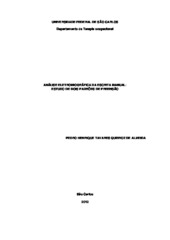Análise eletromiográfica da escrita manual: estudo de dois padrões de preensão

Ver/
Fecha
2012-01-05Autor
Almeida, Pedro Henrique Tavares Queiroz de
Metadatos
Mostrar el registro completo del ítemResumen
Handwriting is an essencial skill for the performance of activities of daily life related to the expression of information in academic, work-related and leisure situations. Among adult population, there is a prevalence of two grasp forms used for handwriting, classified in neurophysiological development as mature or transitional grasps. These grasp patterns may be related to upper limb muscular and postural dysfunctions due to the use of different muscular groups in handwriting activity. The objective of this study was to analyze the electromyographic activity of upper trapezium, biceps braquii, extensor carpi radialis brevis and flexor digitorum superficialis among subjects who use the dynamic tripod grasp and the static tripod grasp during handwriting. Twenty-four university students between 18 and 28 years, without functional dysfunctions of the upper limbs underwent electromyographic analyze during a patterned handwriting task. A significant increase in electromyographic activity of upper trapezium and biceps braquii was observed among subjects who use the static tripod grasp. There was no significant change between the myoelectric activity of the extensorcarpi radialis brevis and flexor digitorum superficialis between the two groups. The increase in electromyographic activity among subjects using static tripod grasp indicates potential higher energy expenditure and increased risk of muscular lesions with the maintence of this motor pattern during handwriting tasks. Since the increased demand for speed and expression of information through handwriting is expected during academic life, the careful observation, evaluation and therapeutic monitoring could stimulate the development of mature grasps and optimize the performance of writing tasks, an important area of intervention and clinical research to occupational therapy.